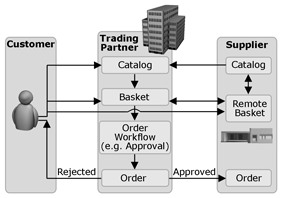Supplier Purchasing Model Using Remote Shopping
Supplier Purchasing Model Using Remote Shopping
Another purchasing model that is reasonable for the supplier and trading partner scenario involves remote shopping. In this scenario, where customers access the product catalog is not as critical as the requirement for the shopping basket, order workflow, and order to be managed within the trading partner environment. As long as the products chosen for purchase end up in a basket that is managed within the trading partner system, the trading partner remains in control of whatever additional steps are required before the order is actually placed with the supplier. The following figure illustrates this model, and shows how the customer interacts with the catalog and basket on the trading partner system, and with the catalog and a temporary "remote basket" on the supplier system. Ultimately, the supplier Web site returns the customer to the basket managed by the trading partner before completing the purchase.

Remote shopping purchasing model
Note that the catalog supplied, if at all, to the trading partner presumably has less detail than the catalog made available through the supplier's Web site. How much less detail can vary. At one extreme, there might not be any individual products in the trading partner's version of the catalog, making it hardly a catalog at all. In this case, the catalog simply has a list of product names and URLs to the complete product detail in the supplier's Web site. In terms of browsing for products, the trading partner buyer application is basically a list of links to these sites.
At the other extreme, the catalog published to the trading partner might be missing only some specialized configuration options. The details of a computer's configuration, such as the amount of RAM and the size of the hard disk, are a classic example. In this scenario, the supplier's remote shopping Web site may look less like a traditional retail Web site with a shopping basket and so on, and more like a configuration wizard.
Regardless of how the supplier and trading partner agree to split the responsibility for product presentation in this scenario, the key point is that the trading partner maintains the only persistent instance of the basket and the original version of the order, and the supplier temporarily maintains a secondary, remote basket.
| Previous Next |
EAN: 2147483647
Pages: 483